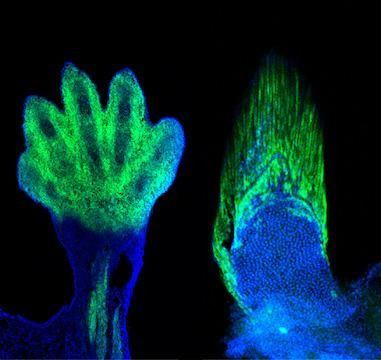From Fins To Fingers: Digit Evolution Explained By New Study

Writing in his seminal “On the Origin of Species,” Charles Darwin said: “The bones of a limb might be shortened and flattened to any extent, becoming at the same time enveloped in thick membrane, so as to serve as a fin; or a webbed hand might have all its bones, or certain bones, lengthened to any extent, with the membrane connecting them increased, so as to serve as a wing; yet all these would not tend to alter the framework of the bones or the relative connection of the parts.”
Even though the book was first published in 1859, evolutionary biologists struggle to this day to answer how the changes described above took place. But in a new study published Wednesday, researchers — using technologies that didn’t exist in Darwin’s time — have found a “cellular and genetic connection between the fin rays of fish and the digits of tetrapods” — the group of all four-limbed vertebrates.
The study, titled “Digits and fin rays share common developmental histories,” appeared Wednesday in the journal Nature and used “novel gene-editing techniques and sensitive fate mapping to label and track developing cells in fish” over three years of experiments. In the paper, researchers from the University of Chicago “describe how the small flexible bones found at the ends of fins are related to fingers and toes, which are more suitable for life on land.”
Neil Shubin, one of the authors of the study, said in a statement: “For years, scientists have thought that fin rays were completely unrelated to fingers and toes, utterly dissimilar because one kind of bone is initially formed out of cartilage and the other is formed in simple connective tissue. Our results change that whole idea. We now have a lot of things to rethink.”
Tetsuya Nakamura, another co-author of the study, used CRISPR/Cas9 gene-editing technology “to delete important genes linked to limb-building” in the zebrafish used for the study “and then selectively bred zebrafish with multiple targeted deletions.” High energy scans showed “that fish lacking certain genes lost fin rays,” which are the bones in a fish fin and are dermal, as opposed to human fingers, which are made of cartilaginous bones. However, Nakamura also found that “the small bones made of cartilage fin increased in number” in the fish.
Andrew Gherke, another member of the research team, mapped specific embryonic cells as they moved around while the animals grew and developed. “It was one of those eureka moments. … We found that the cells that mark the wrists and fingers of mice and people were exclusively in the fin rays of fish,” he said.
© Copyright IBTimes 2025. All rights reserved.





















